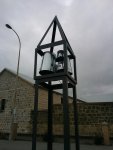ronb28@hotmail.com
New Member
Hello have a project i would like to under take but need some help with the picaxe which i am new to so please be kind.
When young i use to stay with my auntie who had a wind up clock which chimed on the hour for the hour (eg 4 times for 4 o clock)
would like to reproduce the chimes using a picaxe (the tick tock would be the next project) on a 12 hour cycle and would like to
ask some questions if i could ? I see that connecting the chip to a PC is very straight forward with few parts required
I would also add that iam only really need the chime and would not look or use a visual display
What picaxe chip would be best for this job ? is a picaxe the right thing for the job ????
Do the chips have an on board clock ?
If yes how accurate is it ? (a reset every month is ok by me)
Would like to run a small solenoid for the chime any suggestions ?
How long would the pin need to go high to run the solenoid circuit ?
Other than the 5 volt regulated power what else is required to run the circuit
Managed to get a copy of the picaxe editor and getting my head around the Basic programing format ok
I would like some assistance (not done for me ) but wish to learn more about picaxe and progress on to
bigger and better projects
Thanks for your time
Ron ronb28@hotmail.com
When young i use to stay with my auntie who had a wind up clock which chimed on the hour for the hour (eg 4 times for 4 o clock)
would like to reproduce the chimes using a picaxe (the tick tock would be the next project) on a 12 hour cycle and would like to
ask some questions if i could ? I see that connecting the chip to a PC is very straight forward with few parts required
I would also add that iam only really need the chime and would not look or use a visual display
What picaxe chip would be best for this job ? is a picaxe the right thing for the job ????
Do the chips have an on board clock ?
If yes how accurate is it ? (a reset every month is ok by me)
Would like to run a small solenoid for the chime any suggestions ?
How long would the pin need to go high to run the solenoid circuit ?
Other than the 5 volt regulated power what else is required to run the circuit
Managed to get a copy of the picaxe editor and getting my head around the Basic programing format ok
I would like some assistance (not done for me ) but wish to learn more about picaxe and progress on to
bigger and better projects
Thanks for your time
Ron ronb28@hotmail.com

